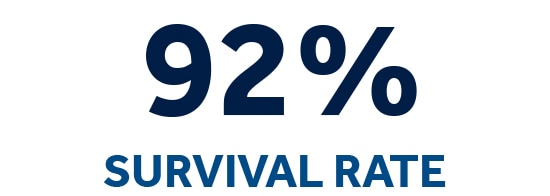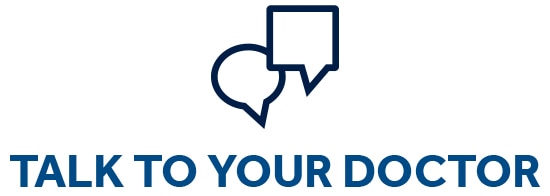Catch cancer early with annual
lung screenings.
Lung cancer moves fast, so you have to move faster.
Annual lung screenings can detect cancer earlier and potentially make it more curable.1 This is too important to put off, even without symptoms or if you never smoked. A growing share of lung cancer is being detected in nonsmokers.2

Every two minutes, someone in the United States is diagnosed with lung cancer.3

When diagnosed early and resected immediately (for stage 1)1,*

Ask your primary care provider to refer you for a low-dose CT lung cancer screening.
Screenings are quick, easy,4 and often covered by insurance when screening criteria are met.

Lung cancer screening is:
- A painless, noninvasive procedure4 that takes a low-dose CT scan of the lungs
- Simple and quick4 — approximately one minute of testing
- Relatively new as a routine health care screening recommendation in the United States4
- Usually covered by insurance for people over age 50 and who meet high-risk criteria5
Why haven’t I heard of this?
Compared to well-known screenings for breast, colon, prostate, and cervical cancer, lung cancer screenings are relatively new.
The first clinical research took place in 2002, and findings confirming the screening’s effectiveness were published in 2011.6 Regular cervical cancer screenings have been recommended by the American Cancer Society since the late 1960s and breast cancer screenings since 1976.

Who should consider a screening for lung cancer?
|
|
PEOPLE AGES 50-80 AT HIGH RISK6About two out of three lung cancers are diagnosed in people over age 65, and most people are older than 45.7 |
|
|
CURRENT AND FORMER SMOKERSSmoking is widely considered to be the leading cause for lung cancer.8 |
|
|
THOSE WITH EXPOSURE TO ASBESTOS OR RADONCarcinogenic chemicals in the workplace or home increase lung cancer risk, especially if you smoke.8 |
Talk to your doctor about lung cancer screening if you — or a loved one — is over 50 with a history of smoking or exposure to carcinogenic chemicals.
Based on 10-year survival rate.
Henschke CI, Yankelevitz DF, Libby DM, Pasmantier MW, Smith JP, Miettinen OS. Survival of patients with stage I lung cancer detected on CT screening. N Engl J Med. 2006;355(17):1763–1771.
Siegel DA, Fedewa SA, Henley Jane, et al. Proportion of never smokers among men and women with lung cancer in seven U.S. states. JAMA Oncol. 2021;7(2):302–304. doi:10.1001/jamaoncol.2020.6362.
American Lung Association. State of lung cancer 2020 report. 2020;1.
Henderson LM, Rivera MP, Basch E. Broadened eligibility for lung cancer screening: challenges and uncertainty for implementation and equity. JAMA. 2021;325(10):939–941. doi:10.1001/jama.2020.26422.
American Lung Association. What to expect from a lung cancer screening. https://www.lung.org/lung-health-diseases/lung-disease-lookup/lungcancer/saved-by-the-scan/resources/what-to-expect-from-lung-cancer-screening. Updated April 15, 2020. Accessed September 30, 2021.
National Lung Screening Trial Research Team: Church TR, Black WC, Aberle DR, et al. Results of initial low-dose computed tomographic screening for lung cancer. N Engl J Med. 2013;368(21):1980–1991.
American Cancer Society. Key statistics for lung cancer. https://www.cancer.org/cancer/lung-cancer/about/keystatistics. html#:~:text=Most%20people%20diagnosed%20with%20lung,25%25%20of%20all%20cancer%20deaths. Accessed September 30, 2021.
American Cancer Society. Lung cancer risk factors. https://www.cancer.org/cancer/lung-cancer/causes-risks-prevention/risk-factors.html. Updated October 1, 2019. Accessed October 25, 2021.